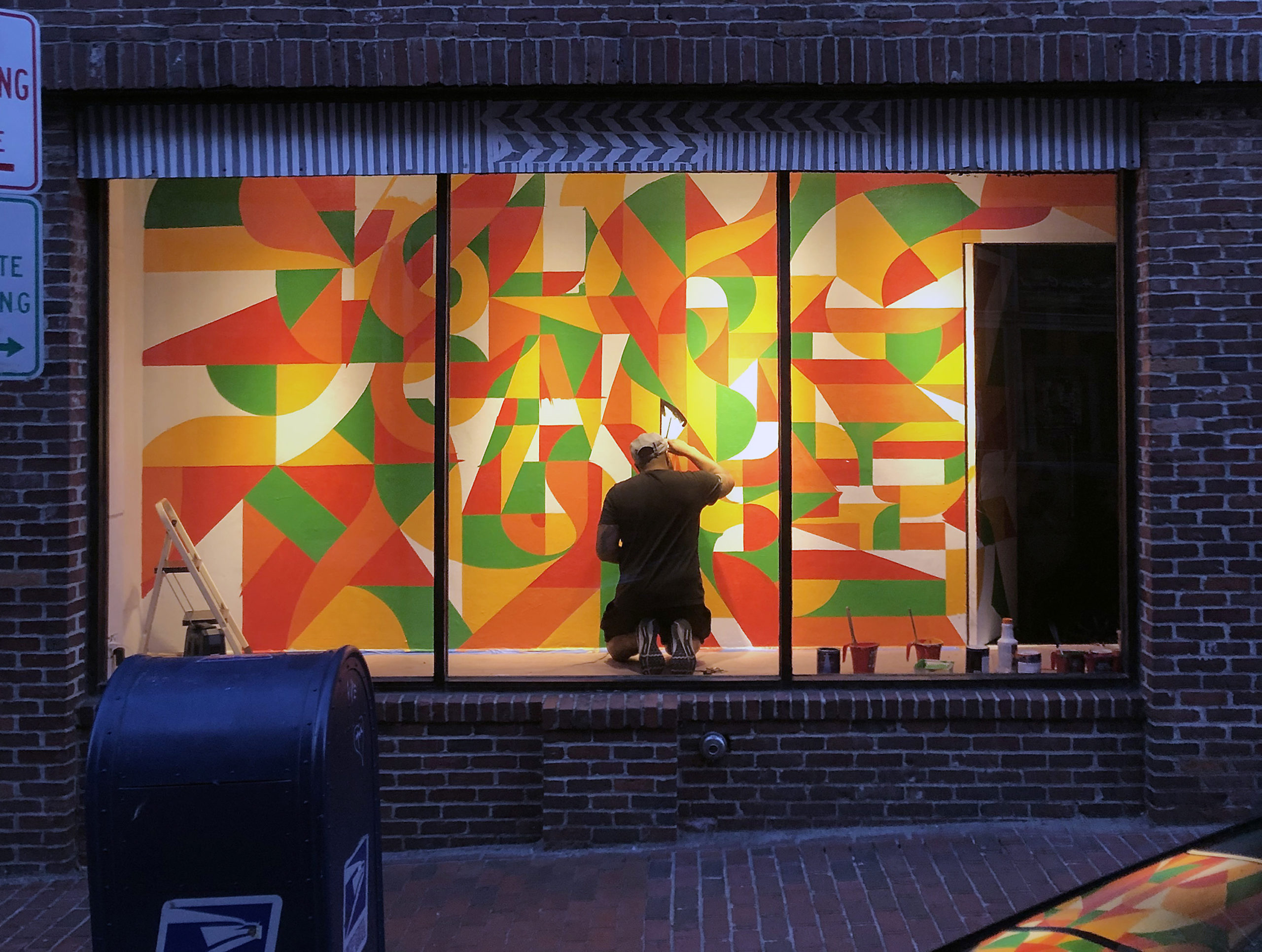I spoke with Ryan Adams shortly after he completed his installation You Can’t Unsee. We discussed some of his past graffiti work in Portland, alternate paths to enriching creative careers, how parenting has impacted his art practice, and the complexities of his experience receiving recognition and opportunities amidst a broader societal reckoning with racial injustice.
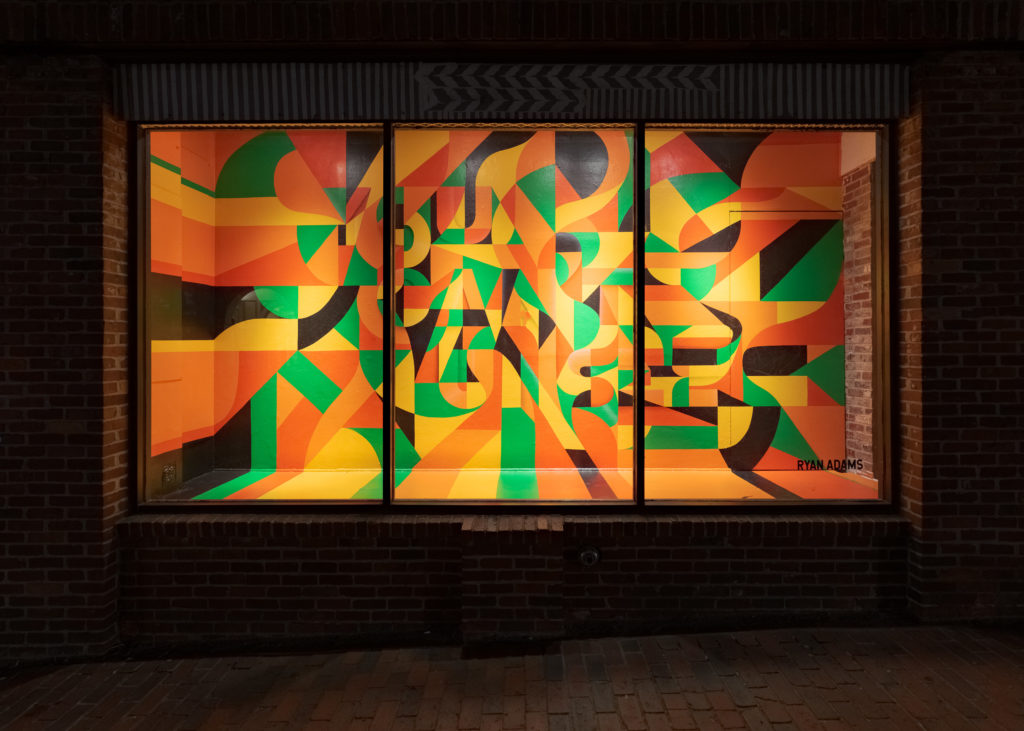
In your statement for this installation You Can’t Unsee, you draw a parallel between a larger societal moment of recognition and renewed attention to longstanding systemic racial injustice, and the surge of new attention and momentum your own creative practice is getting in your hometown of Portland. What is that experience like for you?
It’s tough. It’s only tough because of the range of emotions that I go through with this whole experience. On the larger issue of society going through this transformation and having things exposed to folks who were previously unaware… Obviously I love the fact that people are now taking action and are more aware of these issues. Honestly, it is this perfect mix of us being stuck inside for COVID and then our only access to the outside world being through our phone. And these things happen and are caught on video and they were just so jarring. It was the perfect mix to motivate people to get off their butts and try to make some changes here. In a grand scheme, it’s great. But also it’s nothing new. I am a Black man and I have lived this for 35 years.
The exposure its getting is good and I notice when I do talk about race, it feels easier to talk to people about it now. Before I was more apprehensive. That is a positive side of it.
On the other side it’s scary. People are cooped up, things are uncertain on every front, tensions are high, and people are emotional. I have two little girls. I worry a lot. There is that side of it too.
On a personal level, just the whole thing with getting this attention, I am very, very appreciative. To have people recognize the work I have been doing and get a lot of really positive responses. It does feel good. This work is all an extension of me, every piece draws from that personal well. It’s awesome to be recognized. But having it tied to this movement and this moment is the most confusing and at times aggravating experience. Pretty much every emotion I can think of I have experienced through this process.
There is lots of questioning- Am I just being recognized because I am a Black artist? Is it not my work? Is it because I’m Black and these institutions and companies need to check their box? Am I being tokenized for their marketing purposes?
The last decade I was doing business management and business development and I was very much in corporate America. Very deep in the corporate world with major manufacturers. I always kind of knew the underlying racial issues in that world. It was very on the table and was out there, it wasn’t pretending to be anything else.
With the art world I felt less aware. Since that corporate world was my full time day job I was less aware of the art world and what was happening. But I have had experiences going into galleries and being dismissed- I don’t paint like these people and I don’t look like the artists they know and they find out I work with spray paint and the conversation is just over. That is a different kind of exclusion, a different feeling. The art world is supposed to be where so many different ideas and thoughts should be accepted. Whereas corporate America there was no illusion of that.
How many murals or creative projects have you been invited to do since April?
[Laughing] ……. I only chuckle because my wife Rachel Gloria and I talk about this. As soon as I painted the George Floyd portrait, we had this onslaught of emails and requests and interviews. And I was asked to do some stuff where it was clear that they didn’t even look at my work. It was clear they were just checking a box, and this has nothing to do with me. We got a good amount of those.
But then there were also some really great requests that came in and connections that have been made. There have been so many positives, but I do get in my head about the reasons behind those positives.
You know, I painted a tribute to a man that was murdered on film in one of the most brutal ways I have ever seen. I don’t want to gain monetarily off of that. It was so complicated. When I sat with myself and went through those emotions, I would ask, are people reaching out to me because they are now aware of my work and they want to know me because of who I am as an artist, or are they just wanting to go along with this trending issue or on the coattails of this movement that is happening? There were a lot of discussions with Rachel and I trying to decipher where each person was coming from and what their intent was. We had to do a lot of that and tell some folks to kick rocks.
On June 4th you painted a mural of George Floyd on a wall of Aura, which had at one time been the site of a famous graffiti wall in Portland on the side of the nightclub Asylum. Have you done work on that site before?
Oh yeah! For sure. This is awesome. No one asks about the graffiti side of it. That is the most fun. Graffiti is where I learned a lot about life, first of all. But also my love of letters and bold contrasting colors. My artistic mind was formed by painting graffiti. I love it.
My own personal geometric gem style — The line work and the geometric forms are based on tags, graffiti letters. I try to minimize the base forms of what I can recognize as an “r” for example. Then I chop it up like I would with a can or a marker.
But yes, that space has a great history. When it was the Asylum, it was a graffiti hall of fame- since the early 2000s or even the late 90s. When I was in high school, that is where I went to see pieces. It’s Portland, Maine, you weren’t seeing graffiti that often. It blew my mind. Who did it? How did they do it? How did they get the lines so clean? I started painting that wall in 2009 with Mike Rich– who is just another phenomenal artist and the greatest friend. We also have our dad days, where we get a moment free and we go paint together. It is a special place for us there. I spent a lot of time, sprayed a lot of paint there, and it feels good to have that connection to the place.
It’s strange though. With some of the changed spaces there are more walls open and more permissibility. The mural game is so different now with social media. These are landmarks now, businesses realize it draws people to them. It’s a whole different game. A lot of the places that come in are open to projects. You look at “East Bayside”- I say that with quotes, it’s still Kennedy Park- but you see that area and it’s just covered. And there is work all over the place and that is awesome.
But there was something special about how it used to be. So mysterious. Not really sure how or who made something happen. Is it supposed to be there? Getting away with something. It was a different feeling for sure.
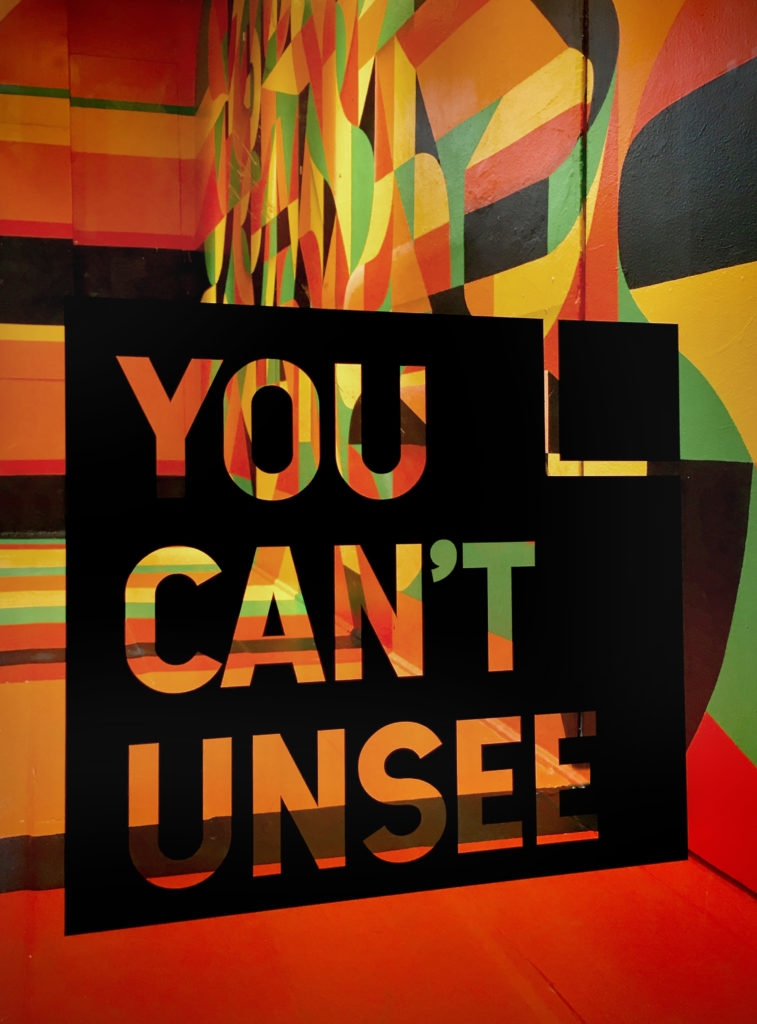
With the George Floyd mural, your participation in the Counting from Thirteen project with Indigo Arts Alliance, and this installation You Can’t Unsee, there is a thread of direct response to the current moment. Have you been responsive to current political or social movements in your work in the past? What feels different about now?
I definitely have. But in the past, I wasn’t screaming that I had done it. I wasn’t taking credit.
It’s strange. I have a weird relationship with what I create. I always was half in the business world and half in the art world, so there are parts of my creative process where I am thinking from a business standpoint. Which works in some cases and completely destroys it in others.
There have always kind of been two different routes when it comes to creating, because I do a lot of client-facing work. I do have to create under client guidelines — it’s my commercial side.
The personal reflection in my work has always been very raw. The watercolors I do, it really started as a visual diary. I was going through a major life change and it felt weird and I needed to time capsule this moment. I knew that I will get past it and I need to do this.
So, there has always been both. But recently there is so much going on and I feel like I have a skill set to use. I can paint something big really fast and if I can put it out there for people to see it, I kind of feel obliged. That might sound strange, but I feel like if I have these opportunities to put it out there, I have to do it. It’s always been a part of it at certain levels, but right now it’s really peaking.
I do like that part of it- being able to make a public statement. It’s really great to feel that your voice is being heard and feel appreciated.
Are there other artists working right now who address racial justice and advocacy in their work that you admire? Who are some of your contemporary influences?
I just did a project with Daniel Minter and I have been a huge fan of his work for a long time. So to talk with him and hear about how these things come to be….I mean. Working with him was a huge deal. I talk to him pretty often now and still I get tongue-tied by the level of introspection, thought, and purpose behind his work.
Also one of my close friends Bee Daniel. Just one of my favorite humans. Definitely family. Their ability to feel the feels. Bee is an empath. The greatest person, but their ability to take those feelings and relay them visually in the way they do is really magic. At first glance, the pieces look happy and joyful and youthful, but then you look more at what is going on and there are some deep heavy issues being confronted in this beautiful packaging. I just love it.
There are also things about the art world that Bee and I talk about often- just how shut off it really is and not accessible to everyone. Some of these institutions, they just have their people, they know what they are looking for, and that is it. They just cycle folks in. It is very insular. I am about burning that to the ground to be honest. With my own personal experiences with that, with being one of the people that doesn’t fit in and feeling that. It’s a terrible feeling. Bee and I are both on the same page with making it accessible.
In some other recent interviews, you have spoken candidly about your own path to becoming a working artist and creative entrepreneur. Do you strive to be that open and transparent as an act of mentorship to a new generation of artists?
I hope so. I really hope so. I think there is an idea that there is a certain route you need to take and certain things you need to do to accomplish your goals as an artist. It may make sense in some capacity, but I have always been the type of person that when then the crowd is going left, I immediately go right. I need to do this the way that feels right to me- this is my work and maybe I am screwing this up, but I have to do it my way.
Especially having the juxtaposition of having the corporate day job – something so rigid and stiff with no fluidity in any of it – knowing this is just the way it is. This is the box. So with the creative side of my life, I really take control with how I want to put my work out there. And with social media, you have more control with how you promote your work and what you are making.
You know what, my advice is just go for it in the way that feels right for you. I hope that that inspires younger folks to really just do you. At the end of this run – me and Rachel say this often – when I get to the end, I will smile if I know I did all the things I cared about and I did them in my own way.
Yes! And for alternate paths to sustainable and enriching livelihoods in the arts — we have to talk about them.
For sure. It benefits schools and larger institutions to tell people to stay on a path because it makes them money. You remember your exit interview from college and they tell you how much you owe? I remember thinking, “I just got hustled”. I looked at the bill and I felt I am screwed for the rest of my life. When you are 18 you don’t understand it and there is so much pressure to go to college. When you deviate from that, something is wrong with you, there is shame. I just felt like I got played. I just got played for a lot of money. I will never look down on higher education, I am all for it. But it doesn’t work for everyone. If you are not going to school, you need to be learning on your own. I am not an advocate for being uneducated, but it should be free and you can do it in so many other ways outside of universities.
I went to Emmanuel College in Boston- a liberal arts school. I went for a Clinical Psychology degree, because in high school even the art teacher was telling me I needed to major in something practical like business. It wasn’t until I was in a drawing class and the head of the drawing department came through and asked my name and major. She looked at me with such surprise and told me “you need to see me after this class.” She was telling me at the very least, I needed to be getting a minor in art. That was a moment where it hit me, this is a thing I am good at. In the high school I went to there was no support really.
There are so many routes you can take, but it is all a struggle too. That is something I wish people would know. I have seen friends and loved ones go through the school system and walk out 6 figures in debt and then you are struggling there. But I also see folks who never went to school and they feel trapped and are struggling there. It is all a struggle. There is no easy path, don’t shut yourself off. Be open to the routes that work for you.
How does it feel to be making a living doing both commercial and personal creative projects? How does it feel to not have to have a “day job” with your art practice on the side?
It hasn’t been long, I quit my job in February. It is still very strange and new. My mood is a lot better and overall I am a lot happier. Because I worked towards this goal for 11 years. I first got settled into the corporate world when I was 25. Once I started paying student loans, that was awesome, but I knew I couldn’t be there forever. This has to just serve this purpose to get me as far out of debt as possible, and then it was like this switch happened where I needed to push on the art side of my life.
To finally take that leap was terrifying. And then 2 weeks later COVID hit. That happened. I was definitely questioning if the universe was telling me I just made the most epic mistake. But it so far has been pretty awesome. Just the level of care I have about everything I am doing is amazing. In the corporate world, there is so much busy work. Now I really deeply care about every single thing I am doing. It is a totally different feeling.
How has parenting impacted your creative life?
I have a 3 year old and an 11 month old. When we had Zoe our first, I remember seeing a buddy of mine I hadn’t seen in a while- Bret Labelle– another awesome artist I love who has incredible technical ability- he saw me and he was like “What happened? The minute you had a kid you just went on overdrive.” And yeah, it kinda slapped me in the face with the reality that now is the time. I know that I want to have this creative career. It put a whole different battery in me. You just gotta go.
Also just getting used to being exhausted all the time anyways. Knowing that I can work on this project until 3am and then be up at 6am. Because I am not sleeping anyways! It has helped me focus honestly. You have to be so much more deliberate with your time. There are only so many hours in the day. To have these little windows when you are not juggling kids and other house responsibilities, you really have to make it happen in that time. I don’t have a leisurely experience at sites where I can take my time. I have to go and be very focused and effective.
That is the biggest impact- just learning time management on a whole other level. And on a not happy side of it, the first year when I did do that with Zoe, I went overboard. I missed a solid chunk of the first year of their life. I missed so much. I was still working a full time day job and I traveled a lot. There was one month where I was only home 3 days a month. It broke me. I am not going to lie. I got to the end of that year and I just bawled my eyes out and I knew I just can’t miss this much of my kid’s life. Family and little ones come before everything to me. I had to learn how to prioritize. So it put a driver in me that pushed me on what I was doing, but I had to find a balance.
How does it feel to be living a life where you care so deeply about what you are doing and to have your children witness that? Everything is an example and kids are watching everything their parents do.
My oldest is on it. She knows my style. We will drive by something and she will point to a mural and say “dada’s painting”. She points it out. She knows Bee’s work too. She will say “Bee did it!” and I will say “yes!”. It is wonderful having them experience it. It is a hustle. Our schedules are not normal and always changing. People that know us are asking, “how do y’all do it?” It is really wild the hours that we keep. But I hope the kids see that. Their parents wanted something outside of the cookie-cutter “this is how you succeed in America” handbook. It is something way left- a muralist? You gotta sacrifice some sleep and you gotta just go. I hope my little ones see that you can do anything. It will come with a price and you have to make it happen. But I hope they are picking up on that.
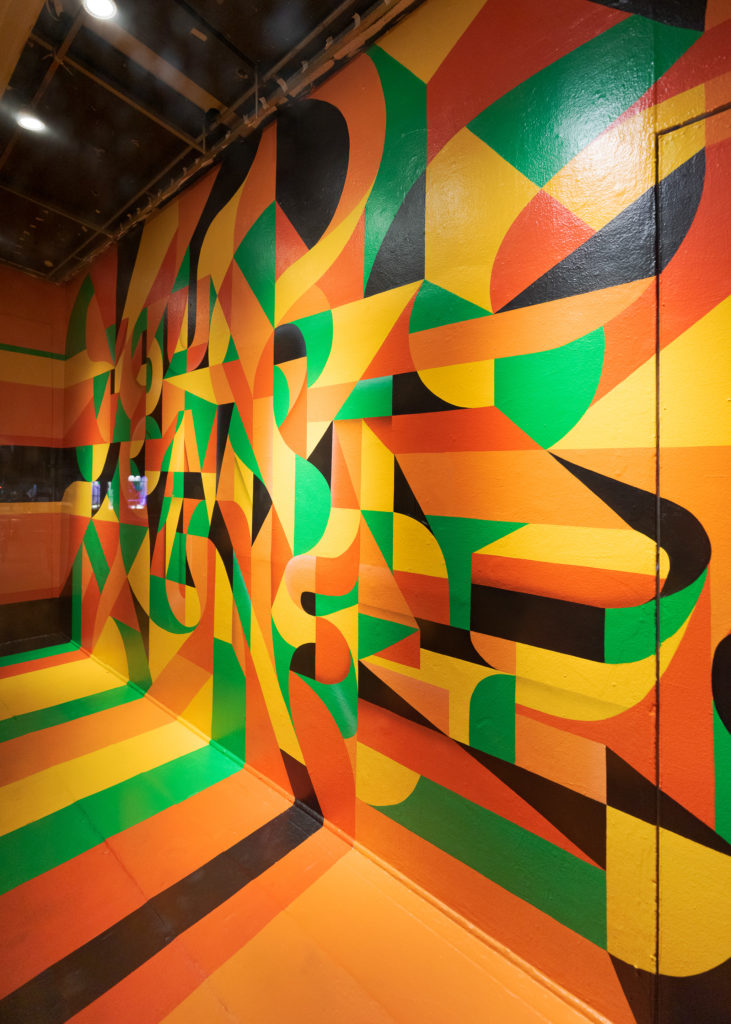
Is there anything else you want to share about your practice right now or reflections on You Can’t Unsee.
One of the things I didn’t mention in the write up, is that the color palette is taken from Kente cloth. It was very popular in the early 90s on the African American fashion front. I had so many things as a kid that my grandmother would give me- Kente Cloth wraps or shirts or backpacks. I pulled that directly from there because to me it was a very uniquely African American color palette in my head. Someone commented on it, “this reminds me of A Tribe Called Quest”. I was like yes! They were using these patterns in the 90s as well. My mom came by when I was painting and she said she liked the colors and I told her the inspiration and she was really into it.
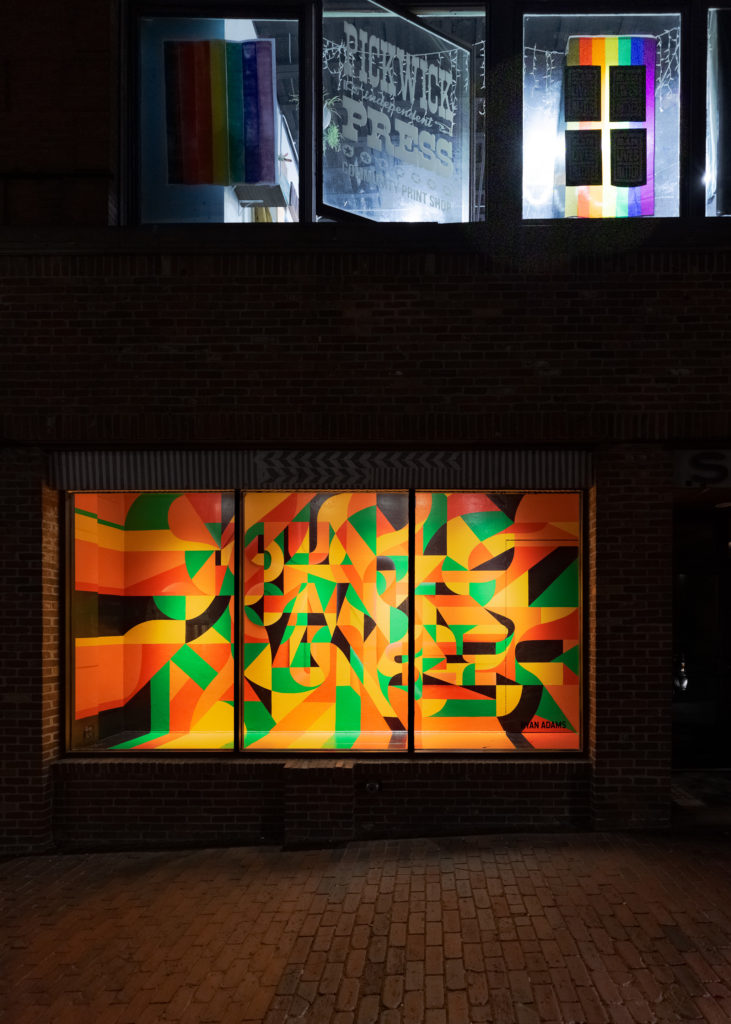
Hero Image credit: Rachel Gloria

